Being completely truthful, the much anticipated first flower spikes of Digitalis parviflora ‘Milk Chocolate’ were a bit of a disappointment. This plant arrived in my garden last year yielding no flowers in its initial (guessing too shady) position so… I moved it.
During the move (sometime in Spring) I took the opportunity to pull my young foxglove plant apart (where it was happy to break) giving me a smaller extra plant as a bonus. I am very much a fan of propagation via division. Yay… this year the main plant flowered with two spikes!
Initially I was happy with the narrow flower spikes of my ‘Milk Chocolate’ foxglove and the scale was right for my border (although I don’t remember noting quite how thin they would be). Mm… but many bottom flowers appeared to dry up and fall away before they even opened. The bells were tiny and a tad scruffy looking too…
Shame I thought… sometimes I make a mental note of plants for my borders after seeing them in garden show displays. I am guilty of remembering the feel of a planting and not necessarily recording actual sizes – I’ll not be the only gardener that gets caught out like that I’m quite sure 🙂
Being truthful again, I had picked this plant for its aesthetic/architectural look as well as its benefit for wildlife and feeding bees in particular. I love to see bees feed from plants in my garden and now that my daughters are no longer ‘playing’ in my garden I do find myself looking out for the ‘bee friendly’ symbol on any new plant purchases. Yep… the garden evolves as our personal circumstances evolve too 🙂
Evolving too has been my garden blog (apologies for lack of posting recently) and the more I take photographs of what visits my garden, the more I want to get better images. For anyone new to garden or wildlife watching I’d absolutely recommend taking photos of what you see as a help to identifying it. You don’t have to have a fancy camera for that either – a mobile phone will do 🙂
Of course, when taking photos of wildlife a keen eye is required and it’s very easy to miss moments in different lighting conditions (like early morning sunshine) as shown below. I had given up the idea of seeing feeding bees on the tiny bell trumpets of my ‘Milk Chocolate’ foxglove and as I enjoyed a sunny Sunday breakfast in my garden last weekend I was thrilled to finally see a bee feeding on my plant. In an instant my plant purchase was verified…
Now, I should add that prior to seeing this foxglove flower I was a bit too optimistic on how this plant would fit in my garden. During my visit to the flower show Gardening Scotland back in June I picked up another five young plants (a good price) to spread the ‘Milk Chocolate’ around this newly cleared and replanted border (more on that another time).
In the border image below you can see the ‘Milk Chocolate’ flower spikes on the right. Next year, the new young plants should flower too and they will flow through the border to the left mixing with deep red astrantia flowers , heucheras, hellebores, white campanulas, cranesbill geraniums and thalictrum delavayi hewitt’s double.
Sitting at my pergola table (which gets flooded with early morning sunshine) and looking across this border to the bird feeders beyond affords many great wildlife viewing and photo opportunities. The well camouflaged feeding bee in the close-up images above is the common carder bee Bombus pacuorum and I nearly missed it completely.
Another new introduction to this border from end of show display plant sales at Gardening Scotland this year are the dark astrantias. I reserved two plants from a display believing they were the same plant but as I see them grow in my garden now I am convinced they aren’t. I plan to mail images to the nursery to ask them. I thought I had bought Astrantia ‘Gill Richardson’ but found labels for ‘Ruby Wedding’ deep in the pots when I planted them. Bee en route to feed below – I’m en route to collect some seed after they’ve finished 🙂
Finally, I can’t leave out the planting of drumstick alliums (Allium sphaerocephalon) in this pergola border which alway afford great photo and video opportunities as bees and hoverflies buzz around feeding from them. I love watching this area especially with a camera to hand.
The light changes in this area quite dramatically and below the hoverfly looks almost transparent. The bee this time is a buff tailed bumble and the thalectrum ‘hewitt’s double’ pom pom flowers look dusty pink in the light when they are actually a deeper purple pink. I’ve spotted bees and hoverflies feeding on the thalectrum and the spider’s web on the right shows that it feeds from here too!
From the Olympics to other personal stuff this summer seems to be slipping away fast! Back in my garden, I need to get back to my new pond works (oh yes, not quite finished yet). Meanwhile, outside my garden I’d like to share chat/the story of an Osprey family I have been following more closely this summer due to my MIL being very interested in it. I’ve been visiting this reserve regularly with her and keep her updated with things via their ranger blog (more on this another time).
Checking in on blog feeds via my phone, I have noticed that I’m not the only blogger lean on PC time and posts over the summer. I’d say that’s not a bad thing 🙂 Where it’s great to share online, we need to get out when we can and experience the great outdoors too – be it gardening, gardenwatching, walking, wildlife watching, taking photos or drawing/painting landscapes or simply just chillin’. Lol… as blogger’s we’d have nothing to write about if we didn’t 🙂
Have fun this summer (gosh are we really nearing the end of August). If you are browsing blogs and find your way here please do share what you’ve been enjoying in your garden and when out and about. I don’t expect I’m the only one that would be interested in hearing about it 😀
This post was written by Shirley for shirls gardenwatch in August 2012.
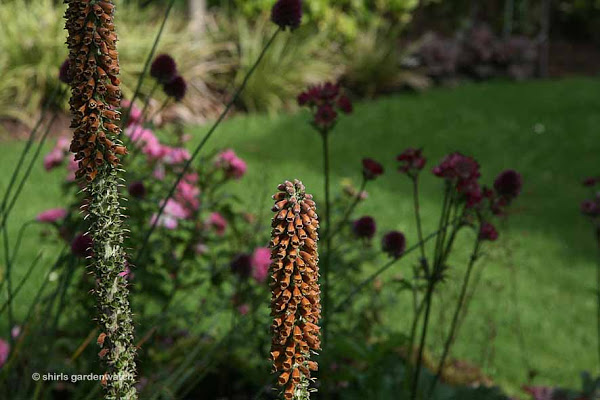
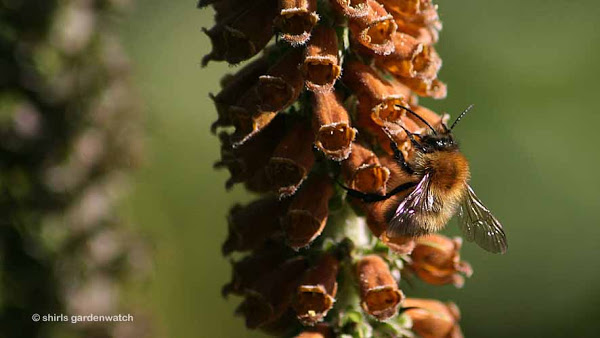
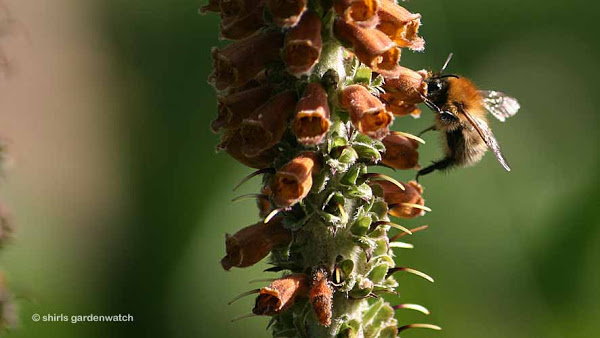
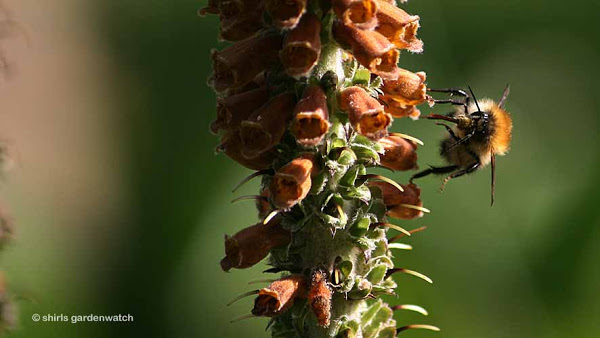
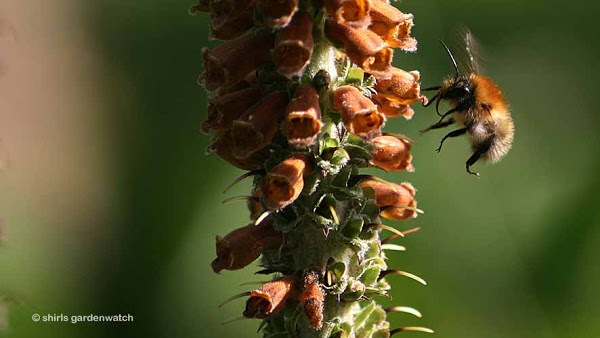
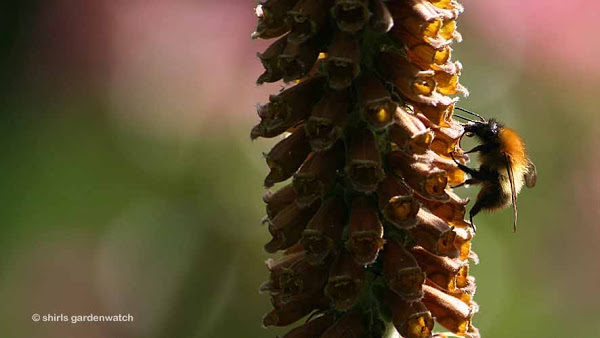
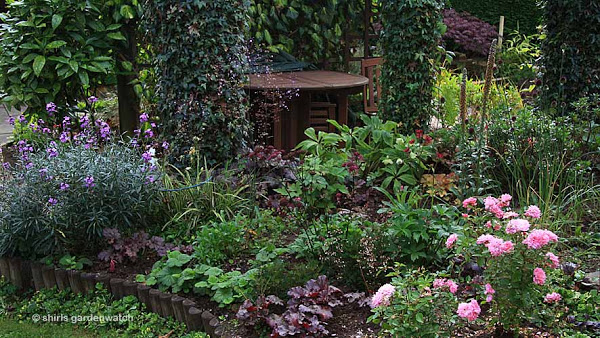
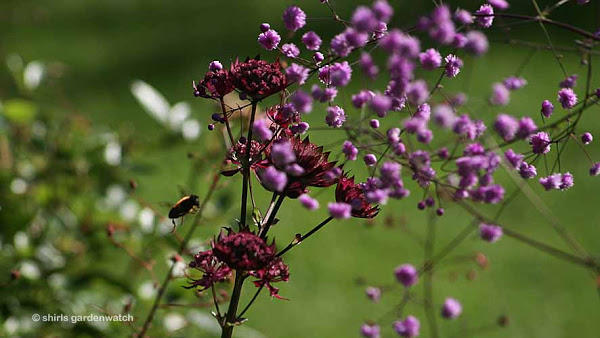
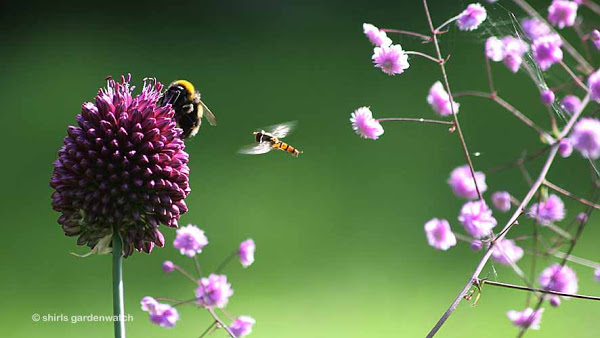
I like the foxglove, it looks very elegant. I also like the way the bee has similar colouring! Posting can take precious time, we all post when we can and read and comment in the same way, so ENJOY and I'll lokk forward to reading more when you have time to post more images. Christina
Seeing your lush border makes my heart sing. It also makes me want to get out into my garden and plant up a storm. 🙂 The foxglove looks tall sticking those big spires toward the sky. No wonder the bees found it. Good to hear you are enjoying the summer. Here we have had drought and record high heat. UGH… Can't wait to hear more about the Osprey etc.
Thinking of being caught out by gardening shows. WE once saw sambucus nigra used as an edging and bedding plant in a border. This was when it was a newly introduced plant. We planted it in an area that we thought would suit it and it grew like Jack's beanstalk!
Love the photos where there are insects en route to the flowers!
I adore those dark astrantias! Unfortunately, I have no luck with them–so I'll just have to enjoy yours from afar. 😉
As far as the digitalis parviflora goes, I grow them–the regular, not 'Milk Chocolate' or any other named variety–and they seem to be very drough tolerant. If they aren't all that happy for you this year, maybe your wet summer is the reason?
You're right that the individual flowers are not quite as showy, though mine bloom more all at once than yours seem to. The best show in my garden is where they are growing in clusters–being planted en masse helps a lot! 🙂
Lovely set of bee photos Shirl. Seems like a plant worth considering. I am impatiently waiting for my new set of Lavender bushes to grow large enough to attract insects.
I love to watch the bees when they come to my foxgloves. They love them don't they.
Your garden looks great
Hello everyone, thanks for all your comments 🙂
Christina, I might have guessed you’d like the look of this foxglove 🙂 I’m in the process of writing a very chatty post at the moment but am too tired tonight to finish it so thought I’d share this plant. I’ve got lots of plants from this year I’d like to share so perhaps the wordless posts are a great way to list them 😀
Lisa, after the drought you have had, I’m delighted to share some lush plants with you. This foxglove isn’t too tall but I love skyward plants! I’m working on one of two stories of the Ospreys, I was thinking of you earlier today when I was writing. I’ve got a bit chatty here but I think you’ll enjoy it 😀
Sue, ah… I bet you are not the only one caught out with plants being used like that – the cheats in garden displays and gardens. I loved those insect shots too 🙂
Kim, I could easily guess you’d love the colour of the astrantias – we’ve similar likes when it comes to colour and texture in the garden I’ve noticed over the years. Yes, possibly our wet summer could have made the foxglove sulk and go over quickly – looking forward to seeing them grow skyward next year already. Yep… I’m a fan of clusters and drifts too 😀
John, thanks, I have to say I’m drawn to plants that I think bees will like. Ah… I’m sure your lavender bushes will grow in no time. I lost ours to winter a couple of years ago. I had had them a few years. However, being at a sunny spot near my front door wasn’t ideal for my daughter who developed migraines so I never replaced them. I loved to see the insects on them too.
notjustgreenfingers, absolutely bees love foxglove trumpets, they love my penstemons too. Thanks, I really should get more garden photos on my blog but time just runs away with me sometimes. I take the photos as a record but posts would be a better record 🙂